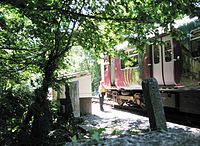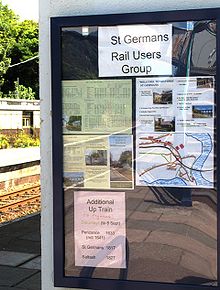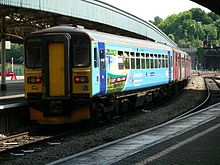- Community rail
-
 The signalling on the Looe Valley Line is operated by the train crew instead of a signaller, but is sufficient to allow freight trains to operate between passenger services
The signalling on the Looe Valley Line is operated by the train crew instead of a signaller, but is sufficient to allow freight trains to operate between passenger services
In the United Kingdom, a community rail line is a local railway which is specially supported by local organisations. This support is usually through a Community Rail Partnerships (CRP) – comprising both the railway operator, local councils and other community organisations – or sometimes by Rail User Groups (RUG). Community railways are managed to fit local circumstances recognising the need to increase revenue, reduce costs, increase community involvement and support social and economic development.
The Association of Community Rail Partnerships (ACoRP) supports its fifty or so member CRPs in the United Kingdom and also offers assistance to voluntary Station Friends groups that support their local stations through the Station Adoption scheme. Since 2005 the UK's Department for Transport has formally designated a number of railway lines as community rail schemes in order to recognise the need for different, more appropriate standards than are applied to main line railway routes, and therefore make them more cost effective.
Contents
Association of Community Rail Partnerships
The Association of Community Rail Partnerships is funded by the Department for Transport as an umbrella group to support CRPs and Station Friends groups. The Association shares ideas and best practice among its members through various channels including conferences and seminars and a quarterly magazine Train Times, also a monthly electronic newsletter. An annual Community Rail Awards event is held each autumn on a different community railway around the country each year.[1]
There are more than 50 CRPs in the United Kingdom, [2] most supporting just one line but some, such as the Devon and Cornwall Rail Partnership encompass several nearby routes.
Designated lines
The Department for Transport announced a pilot project in 2005 under their Community Rail Development Strategy,[2] with the intention of having seven differing lines test out different types of community rail schemes. The aims of these schemes[3] are to:
- establish the contribution of Community Rail Development in achieving locally set objectives such as reducing road congestion and increasing accessibility;
- establish the costs for the line and services;
- establish the effectiveness of different methods for reducing the net financial loss of Community Rail lines by increasing revenue and reducing costs where practicable.
Designation does not physically separate a line from the rest of the network or remove it from either Network Rail or franchise operation. It is not generally intended to be used as a mechanism to reopen lines or create "microfranchises", although these options may be investigated on some routes.
In addition each line has a remit agreed in a "Route Prospectus" which gives more detailed aims and objectives for each scheme, such as infrastructure improvements, new ticketing arrangements, or cooperation with other local transport operators.
The DfT has identified about 50 routes in England and Wales that would benefit from designation, covering 10% of Network Rail and some 390 stations. [2] Some routes will only be designated as community rail services (rather than community rail lines) as the infrastructure may be used by other operators in a way that precludes designation. The routes designated so far are:
- July 2005.
- Esk Valley Line – Middlesbrough to Whitby (pilot scheme)
- St Ives Bay Line – St Erth to St Ives (pilot scheme)
- Abbey Line – Watford Junction to St Albans (pilot scheme)
- September 2005
- Penistone Line – Barnsley to Huddersfield (pilot scheme)
- Looe Valley Line – Liskeard to Looe (pilot scheme)
- Tamar Valley Line – Plymouth to Gunnislake (pilot scheme)
- March 2006
- July 2006
- Poacher Line – Grantham to Skegness (pilot scheme; service designation)
- Derwent Valley Line – Derby to Matlock
- September 2006
- Tarka Line – Exeter Central to Barnstaple
- Atlantic Coast Line – Par to Newquay (service designation)
- Maritime Line – Truro to Falmouth Docks
- November 2006
- Marston Vale Line – Bletchley to Bedford (service designation)
- East Lancashire Line – Preston to Colne
- Gainsborough Line – Sudbury to Marks Tey
- February 2007
- Wherry Line – Norwich to Lowestoft (service designation)
- Wherry Line – Norwich to Great Yarmouth (service designation)
- Barton Line – Cleethorpes to Barton-on-Humber
- March 2007
- Clitheroe Line – Manchester Victoria to Clitheroe (service designation)
- September 2007
- Medway Valley Line – Paddock Wood to Strood (service designation)
- Bittern Line – Norwich to Sheringham
- April 2008
- Lakes Line - Oxenholme – Windermere
- South Fylde - Blackpool South – Preston Line
- Severn Beach Line - Bristol Temple Meads - Severn Beach (service designation)
- July 2008
- Lymington Branch - Brockenhurst - Lymington Pier
- November 2008
- North Staffordshire Line – Crewe-Stoke-Derby (service designation)
- September 2009
- Cumbrian Coast Line – Carlisle – Barrow-in-Furness (service designation)
- January 2011
- Bishop Line - Darlington - Bishop Auckland (service designation)
- September 2011
- Preston to Ormskirk Line
- October 2011
- Heart of Wessex Line: Bristol - Weymouth (service designation)
Station friends
 The St Germans Rail Users Group's noticeboard
The St Germans Rail Users Group's noticeboard
A number of smaller stations have been supported by local voluntary groups for many years. The concept has now been formalised by many train operating companies which operate Station Adoption schemes.
Station "friends" groups or "rail user" groups care for their local station in various ways such as planting flower beds and litter clearance. Many of them actively promote the train service by printing and distributing timetable leaflets, maintaining community noticeboards at their station, and even operating websites.
References
External links
Categories:- Rail transport in the United Kingdom
- Community railway lines in the United Kingdom
Wikimedia Foundation. 2010.

